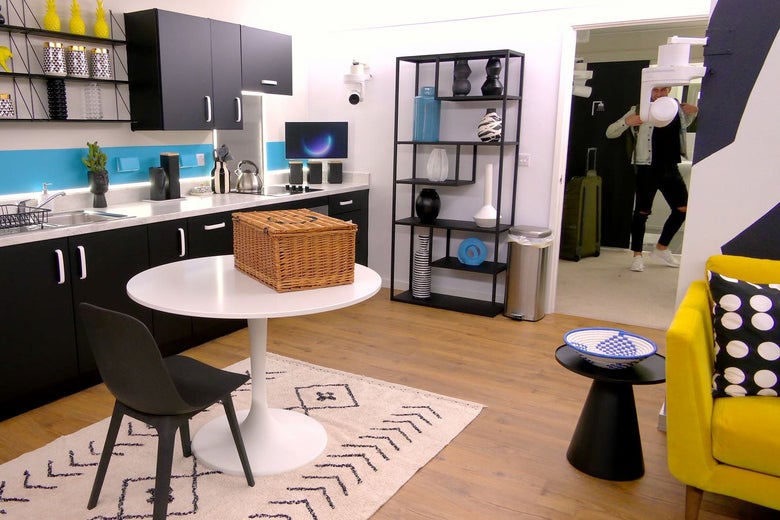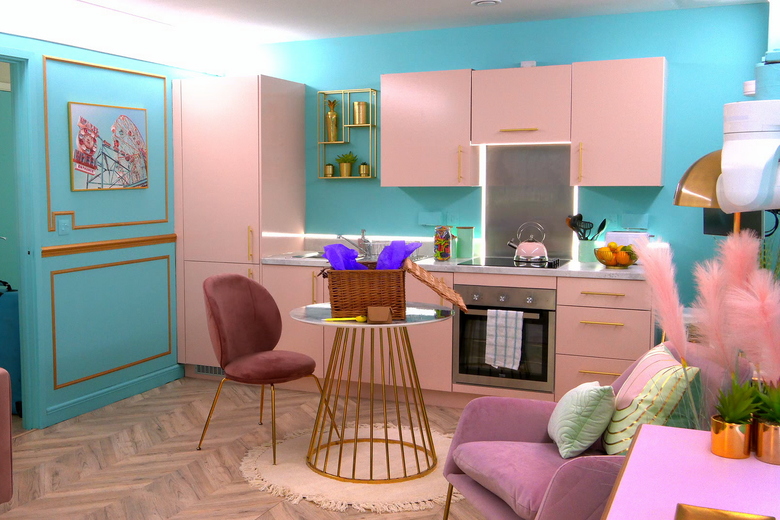The apartments’ interior design, explained.
Unlike other reality competition shows that are filmed on beautiful islands, in charming foreign locales, and other visually pleasing backdrops, on Netflix’s The Circle, the rotating cast of contestants never leave their apartments. This makes it pretty crucial that those apartments at least be interesting for both the competition show’s players and its viewers to look at. And by and large, the producers succeed at making them that way: The contestants—there are usually about eight active players at any given point—live in spaces full of bright colors, trendy décor, eye-catching furniture, lush plant life, and other well-appointed details. I’m sure I’m not the only viewer who’s occasionally caught myself thinking that I wouldn’t mind being isolated in that apartment building for a little bit.
The woman tasked with staging each dwelling is Catherine Land, the show’s production designer, who agreed to speak to Slate about creating the show’s aesthetic, how she designs dozens of apartments at once, and a few things that viewers don’t see on screen. We spoke just prior to the second season’s finale, which dropped on Netflix earlier this week. Our conversation has been condensed and edited for clarity.
Heather Schwedel: I’m excited to talk to you! I can’t believe how much The Circle I’ve watched over the past few days.
Catherine Land: And you managed to keep up with it? I find it so confusing sometimes. I’m like, “Who are you trying to be now? And who is who?” I just go in every now and again to check what the rooms are like. So I’m totally confused [by] what’s going on, but the rooms look OK.
How did you get involved with the show?
I’m a set designer in the U.K., and the production execs rang me up because they knew me from previous shows, and they said, “I think you’d be great for this role.” And I was like, “Oh yeah, it sounds brilliant,” because everyone wants to do interiors, don’t they? That’s a lovely job.
Normally I do set design or performance design. I work on Dancing With the Stars, and I do the performance design for those acts. Or I do set design for [what we call] magazine shows, like The View or something like that, I would do. You rarely get to do interior design, which is such a fab job, isn’t it? Everyone’s already doing it in their own home. So I was like, “Yeah, great. Let me onboard with that.”
Do you have to design all the apartments at once?
The first season for America [in 2020], we did 10 rooms, but we also had to do [the Brazil, France, and the U.K. versions of the show]. So it was 40 the first year, and then last year, it was 30. We need to make them all look different, so it was a big challenge. You’re like, “Wow, OK.” But it’s such a great job. And then we’ve got it coming up again this year. It’s going to be around 30 or something.

Netflix
Are you able to reuse any of the rooms on another country’s version of the show, or do you need all new designs every time?
No, we have to redo them. It’s one of my bugbears. We do them for the U.K., and we have an amazing room, and then they say, “No, we can’t have it because it’s already been in the U.K. [version of the show], so you have to do a fresh room for America.” And you’re like, “But this room is so amazing!” Every season in every country, they need 10 unique rooms of their own. So by now, I think I’ve done 100 rooms or something.
Did the producers give you instructions about how they wanted the apartments to look?
For the first [season] in the U.K., I didn’t do it. A lovely set designer did it, but all the rooms looked the same. So it looked like a hotel, and it was fine. It looked lovely, but it didn’t look really luxe. [The producers] felt like they wanted to move forward with a bit more of an exciting remit. I came in and said, “I want every room to look different, so when you see it, you know you’re in Sandra’s room, or you know you’re in Ian’s room or Chad’s room or whatever.” They brought me in on the second year for the U.K., but the first year for America. They said, “OK, go for it.” And then they came back and they were like, “Oh my God, it all looks a bit crazy!” And I was like, “Yeah, it’s fine though, it’ll be good.” Then they loved it. It worked out.
How long do you have to do this? Are you working on all 10 rooms at the same time?
I design them across a month. But then we only have about one week to two weeks to put all the rooms in, to redecorate them and do them all. America’s normally [filmed] first, so that’s great, because we get a bit longer for America. You can probably tell. You get more bang for buck on your screen, because I had more time to work on those.
I do loads of research for the whole year. I’m doing research on interiors, taking inspiration from really great interior designers or artists. There are some amazing British artists that always [make me] go, “Oh God, I want to do a room like that.”
How does each new design start? Do you give each room a name or a defining concept?
Sometimes. When we did the first American series, we called them all like, “L.A.,” “New York” “the Hamptons.” We gave them all names. Like, “This is Maine.” For us, it was funny, because obviously we don’t live in America. One room we called “The Kardashians.”
I’m 41, but you have to be mindful of the target audience, which is 20-year-olds. So you have to be sort of funky and vibrant. And also 20-year-olds, I think they’re way more aware of interiors than I ever used to be when I was their age. Interior design is such a big thing now for 20- to 25-year-olds; they all love to make their own homes what they are. We didn’t have access to all this amazing furniture when we were their age, because it used to cost a lot of money. But now there are such amazing options on the high street that they can really go to town in their own homes. So you’re just always searching for what 20- and 25-year-olds really want to see in their own homes.
Do the producers tell you anything about who’s going to be staying in which apartment unit or have you tailor them to specific contestants?
I create 10 different ones , but then the producers decide who to put in the rooms because they go, “Oh, that person’s really great to go in that room. They’d love that room.” They pair them with the rooms, basically.
Like this season, Chloe’s apartment is so Chloe, it’s so colorful and bright.
That’s perfect for her. The producers paired her with that room because they liked it.
But then sometimes someone has a room that isn’t like them at all, or maybe matches their catfish personality instead of their actual personality. This season, Jack, the guy who’s pretending to be a pretty blonde girl named Emily, had this very girly apartment, which I thought was so funny.
I love that as well. But even then, sometimes they’re like, “Oh, actually, I kind of like it,” when they’re so not suited to that normally.

Netflix
Where do you source the artwork and other little accessories?
Well, I design all the artwork myself, because I used to be an illustrator. I really like the fact that my artwork is all around these apartments. When anyone goes, “I love the artwork,” I’m like, “Yeah! I did that! That’s mine!”
What is there about the apartments and designing them that you think would most surprise people who watch the show?
What you don’t see is that the walls aren’t really the walls. We put fake walls up because of all of the sounds and camera cables and the lighting cables, so they all disappear. Even the cables for the plasma TV on the wall, they all disappear behind that wall. The apartments aren’t that much bigger when you take the fake walls down, but all the walls that you see are actually built on top.
I was wondering about that, if there’s enough space for people to be filming the contestants inside the apartments and following them around and whatnot?
Oh no, it’s all fixed rig. Fixed rig means that there’s hidden cameras and fixed microphones, so there’s no crew following any of these guys around. It’s all in the room, and they’re the only person in the room, wherever they go. They really are isolated, because if they saw anybody else, it’d be weird for them, because they’d be like, “Hey, so have you seen Dan? Is that really a girl or a boy?” So they’re literally just on their own, completely isolated. Everything is hidden. Microphones, cameras, everything.
Slate is covering the stories that matter to you. Become a Slate Plus member to support our work. Your first month is only $1.
Join
